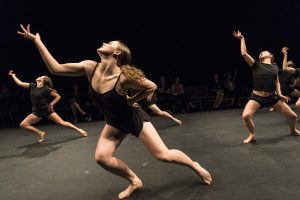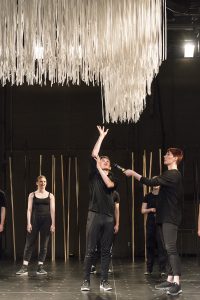The Creative Gesture: A Banff Centre pilot program digs deep into making dance - Vancouver Ballet Society
- Home
- Features 2015 - 2019
- The Creative Gesture: A Banff Centre pilot program digs deep into making dance

by Kaija Pepper
“Are you here? We can’t see you, the lights are in our eyes … We can’t hear you when the music plays.”
These sentences were projected onto the backdrop near the beginning of Still, a 40-minute work co-created by mid-career artists taking part in Banff Centre’s Creative Gesture workshop in summer 2016. The words reflect the performers’ point of view, which is almost the complete opposite to the typical audience perspective: sitting in the darkened auditorium, we see dancers best when the lights are up, and when the music sounds, we are swept into their experience.
By emphasizing the divide between us, the audience was brought into the onstage world from a different perspective. Relationship was created between dancer and spectator, so we could slide easily into the piece. There were more words (some recorded, some spoken live); there were lights, of course, and costumes (white dresses and wraps) and props (long sticks).
There was also the set, which was one of the starting points for the piece. Early on, German costume and scenic designer Alexander Polzin created a central hanging sculpture of white ribbon, as well as a floor covered with a grid of small circles. The sculpture, especially when it lowered, and the dots, which guided the footfalls of the first solos, provided spatial parameters around which the movement could be organized: they were still points for the active moment of dance.

Still was presented at the Banff Centre’s Margaret Greenham Theatre, nestled in the Rocky Mountains of Alberta, at the end of four weeks of an intensive workshop led by program director Stephan Laks. An ex-dancer (Les Grands Ballets Canadiens de Montréal, Göteborg Ballet and Bern Ballet), Laks currently works as a rehearsal director, mostly in Europe. I spoke with Laks and Emily Molnar, who took on the position of artistic director of dance at Banff Centre in 2014, and who also heads Ballet BC in Vancouver, in their production office the morning after seeing the show.
The workshop for mid-career dancers, who gathered from companies across North America and Europe, was intended to provide “a developmental experience,” says Laks. The plan was that Brazilian-born, European-based Fernando Melo, a lead faculty member at the Creative Gesture, would create a new work on them. As it turned out,something different began to percolate in the hothouse space and time provided by Banff Centre.
As they shared ways of working, and read the literature Laks assembled (from a short excerpt about cultivating a spirit of generosity to a scientific paper on how gesture is perceived during social interaction), the group was drawn to going further into the challenging unknown by co-creating the work. These experienced professional interpreters were, after all, used to being in a variety of creative processes that end up with them onstage in a performance. The focus shifted, not without some angst and soul-searching from leadership and participants, but in a spirit of exploration and adaptation in keeping with the pilot program’s research intentions.
“A really important part of what this [inaugural] program taught us all was about leadership and ownership in the creative process,” says Molnar. “And how much communication is needed.”
How do you actually make a work with a group in which everyone is equally invested in decision-making? After a period of trial and error, of developing ideas, and as the performance date neared, the leadership team “began to collect all that energy” to help shape the final piece, says Molnar. In the program credits, the original 10 participants are listed as developing Still, with the four who remained with the choreographic process through to the end— Cecily Campbell, Mariko Kida, Shumpei Nemoto and Javier Perez — credited as creators.
The second contingent of the Creative Gesture workshop involved 12 emerging artists, also assembled from North America and Europe, who joined in as performers for Still. They also had their own piece, the 15-minute Exquisite Corpse, which opened the evening of performance at the neighbouring Eric Harvie Theatre (the two theatres are in the same complex), a kind of hors d’oeuvre assembled by three choreographers — Jermaine Spivey, Tilman O’Donnell and Adi Salant. The audience was invited to sit onstage, with the dancers performing in a rectangular “runway” that ran between rows of chairs, a setup that meant we could watch them closely and, also, the spectators across from us; and the performers, of course, were near enough, without lights in their eyes, to see the audience.

Each choreographer came to Banff for a week, contributing a “chapter” of the three-part work. The title and process were inspired by the surrealist’s Exquisite Corpse collaborative technique, based on a parlour game in which each participant would draw an image or write a word, then fold the paper and pass it to the next person, resulting in a surprising collaged creation.
Exquisite Corpse was brash and bright, raw in its energy, and optimistic, too; the young dancers were committed to their act of communication, each chapter taking them into a different realm of aesthetic purpose. Spivey’s opening featured mysterious, angular movement that I learned later was based on the ordeal of auditioning; O’Donnell’s chapter built character and situation, incorporating monologues with first-row audience members. The last section, from Batsheva co-artistic director Salant, was full-out Gaga-based movement to pulsing drums.
The audience smiled appreciatively throughout (I couldn’t help but watch the faces across from me), but does a workshop need a “final product”? Having a performance “gave the dancers something to puzzle,” says Molnar.
“It also brings them into conversation with the audience,” adds Laks. “Does this thing they have been working on actually work as performance?”
As for the surrealist’s game, it was a means to an end. Laks explains: “We used it for what it supported in terms of bringing the emerging artists to a point of view that questioned authorship, questioned collaboration and ways of collaborating. And for drawing out associations to help them perform with new techniques, new tools.”
New ways of working were key to what the Creative Gesture was designed to investigate. Faculty member Ellen Lauren, for instance,who co-directs SITI Company in New York, provided what Laks describes as “a window into a value system and a culture. The way they work in SITI Company is they sit down for three weeks at a table before even picking up a script. When they do, they have a body of topics and subjects, and they apply those.”
This is, says Molnar, “a very different way of working from dance, where we tend to get up and start moving right away.”
In the fifth and final week, participants from both mid-career and emerging groups, as well as a few new faces, were involved in a Choreographic Lab exploring improvisation with six choreographers, under the direction of Michael Schumacher. Today, choreographers commonly credit dancers as collaborators or even co-creators. In terms of generating material, says Laks, “improvisation is at the heart of the relationship between an interpreter and a choreographer.” It is key to generating movement, and tools, tactics and strategies are key to good improvisation.

Schumacher is an ex-dancer with Ballet Frankfurt and Twyla Tharp Dance, among others, and co-creator with, notably, Jirí Kylián (for 2008’s Last Touch First). He is also a master improviser. In his introductory session, Schumacher provided an eloquent entry into the improvising body, beginning with his own history in dance. He had wanted to be in musical theatre, but then discovered Juilliard School, in 1978, where American modern dance choreographer Hanya Holm gave “cryptic sessions, speaking about perception and awareness.” Over time, as a performer, Schumacher moved from “a world of impulse, freedom and ecstasy,” bothered that he couldn’t remember afterward what had happened onstage, to somatic practice and “a world of awareness that helps me stay awake in performance.”His understanding of the interaction between the intuitive and the rational side of performing grew.
Next year, this elite five-week opportunity that includes travel, accommodation, program fees and even a small stipend for successful candidates, will doubtless evolve. “We created an environment where questions could be asked,” Molnar says of 2016’s investigation into where emerging and mid-career interpreters are at today in their careers and creative lives. As Schumacher sensibly advised the dancers when they began to improvise after 45 minutes of sitting and listening: “I want you to go slow now, so you can keep this awareness later. We’ll get to the fancy dancing.”

